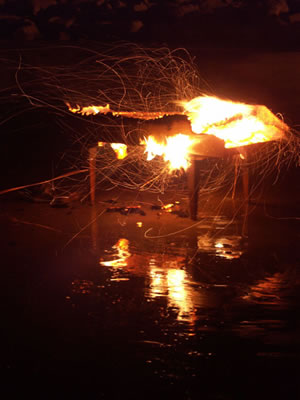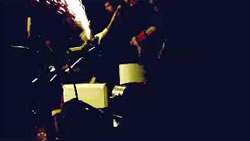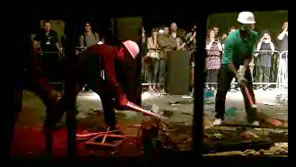Scrapyard Aesthetics and the Swansong of the Inspiron

In March of 2006 I placed a harpsichord on a beach in Scotland and set it on fire. It wasn’t the first time that I’d destroyed something in the pursuit of art. 1[1. See for example my work Harpsichord:burning, which I performed in 2006 and discuss briefly below.] In 2000 I performed the work five improvisations on the destruction of opera 2[2. Released in 2002 on ecolirecords, now defunct. The piece can be heard on the author’s website here.], in which I burned, scratched, soldered, and broke several opera records as I improvised with them over the course of an hour; the record player in that piece eventually caught fire as well. And in this most recent piece, dismantle for laptop (solo), I slowly destroyed a laptop while accompanied by three junkyard percussionists as part of the latest Scrapclub event in London.
When I originally conceived of dismantle, I imagined that it would best be performed by four performers, though in the score I indicated that it was open to one or more performers for any available duration. Not that the “score” was of any consequence, it was merely a way of reminding myself about the piece. In my own work, I’ve always kept in mind what a friend of mine, Rick Reed, once said: “Scores are great as long as you can abandon them for a better idea during the performance.” I’ve always found this to be a useful approach to performance (and life), that is, to have a plan but be willing to abandon it if it doesn’t match the situation. This turned out to be true of this realisation as well but more on that later.
The main idea of the work, as indicated by the title, is to slowly dismantle/destroy a laptop using an assortment of tools (drills, saws, files, screwdrivers, hammers etc.) with the resulting sound providing the acoustic material of the piece. In fact, other than the obvious performative element of the work, the resulting sound is the piece. The players are meant to be aware of the sonic dimension of their actions, and yet, not be overtly musical or reactive. Instead, they are asked to focus on the task of taking apart their laptop while creating/discovering interesting sounds in the process. It’s a difficult æsthetic to communicate, reminding me of when I had performed several Fluxus works in which performers were directed to perform a task for the sake of that task, and yet be fully aware that the task being performed was also a “performance” in and of itself. 3[3. In this realisation, however, I was performing the work as a solo, so communicating the desired approach wasn’t an issue.]
The performative element in dismantle, however, is no small part of the piece and in many ways responds to the many comments levied at laptop artists such as, “It looks like they’re just checking their email” etc. No question about that in this case. But it also explores many of my own interests in using found objects in performance, or treating well known objects (or instruments) as though they were unknown and exploring them in ways that might run counter to accepted practices. Why? Primarily because I’m interested in what else might lie within the object that normally would be unattainable by traditional means or perhaps considered unacceptable æsthetically, and challenging those reservations. It also resists many of the still prevalent ideas concerning musical technique and authorship and challenges these ideas by positing the emergence of the work at the point that the drill meets the keyboard, so to speak, in an act of discovery rather than recovery of an already determined work. In other words, the musician acts more as a sculptor exploring and reacting to (and perhaps against) the contours of an object/situation rather than recreating something with a predefined/determined outcome.
Having said that, I still had an idea of how the piece might “go” and had originally anticipated that the performance would be similar to many of my other concerts in which the audience sits quietly attending the sounds as carefully as the performer. In many of my performances, the sounds that I’m performing on stage are new to me as well and it’s as though both audience and performer are discovering them for the first time. In dismantle this was especially true in that the sounds discovered were the result of the careful exploration of the material aspects of the laptop as a found object, something that I had not done before and that could not be easily practiced (without sacrificing a laptop at least). This is in part the double-attraction of this “destruction” æsthetic to me, that is, the fact that each realisation of the work is finite in that the material (i.e. the object, both in terms of the “thing” being explored, but also the process of exploring it) is limited to that one meeting of concept and performance; its lifespan is tied to that of the object. 4[4. Something that reminds me of the natural materials used in Cage’s Child of Tree and Branches work in which the natural materials used within the work rarely survive the performance.] The exploration of the material aspect of an instrument or device in the search of new sonic possibilities, even if that means taking the instrument to its inevitable collapse or destruction, is a voyage of discovery that begins again with each realisation of the work. In some cases, the destruction of an object is the only way to discover the sounds that one is interested in (such as in my destruction of opera work), while in others, its more about the experience itself (Harpsichord:burning).
There are other concerns, of course, such as what it might mean to destroy something rather than preserve it. In many cultures the act of burning something isn’t considered violent so much as cleansing. In Scotland, for example, they still celebrate various fire burning ceremonies that are thought to have originally been intended to “drive out the evil spirits of [the] old year and welcome those of the new.” 5[5. “Blaze of glory: New Year fire festivals.” VisitScotland.com. Last accessed 5 June 2010.] This isn’t far from my own extra-material interests in destroying some of these objects in the course of a work. For instance, although in Harpsichord:burning I was interested in what I considered the beautiful ephemerality that was revealed by watching such a lovely instrument slowly burn away, layer by layer, against the blue-black moonlit sea, I was also critically aware of the fact that my choice of a harpsichord, rather than a mixing desk, had a very different implication. For myself, the burning of the harpsichord didn’t so much symbolise a jettisoning of the past, as it did a release of the incessant clinging to tradition (any tradition) to the degree that it stems creativity and responsiveness in the present. To be honest, the burning of the harpsichord was perhaps the most creative (and honest) act that I could contribute with the instrument at that point in my practice.
The idea for dismantle actually grew out of an online conversation about Harpsichord:burning. Although I was aware that the piece might be controversial, I was surprised by who was most upset. I had predicted that it would be the older artists (by older, I mean older than me, which as I rapidly approach 39+, doesn’t seem so old anymore). But to my surprise, it wasn’t the older generation, but the younger who were upset. Those who had been around in the 60s sent me joyful emails about their “first piano burning” and wished me the best of luck. 6[6. I exchanged emails with Annea Lockwood who was very supportive. Her own work from 1968, Burning Piano, is well-known and I’m sure existed somewhere in the back regions of my mind in relation to my own work.] Contrarily the younger “kids” couldn’t seem to understand why I wanted to destroy such a beautiful instrument (Whah? Really?) and suggested instead that a more powerful statement would have been to burn a laptop. It wasn’t the piece that I was interested at the time, but the suggestion stayed with me and eventually led to this work.

There are implications, of course, involved with the choice of this instrument to destroy as well. As I had mentioned, this work responds to many of the objections to laptop performances that are so often bandied about, such as the typical email comment, the lack of movement-to-sound association, the almost autistic relationship between laptop performer and audience, and the like. I’m sympathetic to many of these comments, and yet, as a performer that often works with a laptop (as well as other electronics) I’m also a member of the offending camp. In some ways, I’ve always felt that the comment about not being able to see what a laptop artist was “doing” seemed to be an empty comment that veiled a more dismissive attitude that they’re not actually doing anything. And yet, for me, nothing feels more embarrassing than watching a laptop artist “play” expressively. I mean, unless I’m way out of touch with current technology, laptop keyboards do not have aftertouch, so asking a laptop artist to be more demonstrative in their performance is sort of like asking someone to put a bit of English on the light switch as they turn off the lights. This lack of physicality relates also to the laptop’s almost infinitely malleable ability to “play anything” that denies its unique material aspects as a physical object; one can be replaced by another with similar specs and software with little difference to the resulting sound. This work, then, responds to these ideas (and a few others), while still being “about” the discovery of unique and interesting sounds within a live performance.
In regards to the performance, although I had anticipated a zoned off performance space in front of a quiet, attentive audience, once I arrived at the venue I realised that the entire context of Scrapclub was different from what I had imagined. 7[7. YouTube user “wordsintosound” has posted the video “Scrap Club bocking street warehouse 2010” (26 May 2010, dur. 4:45) that shows a slightly visceral take on the sound and general carnage.] Closer to the relational æsthetics of Nicolas Bourriaud than a traditional concert setting (and more engaging) the entire event revolved around an arena of sorts in which the audience became participants in the event. Standing at the centre of the arena, organisers Wajid Yaseen and Joel Cahen called out ten names at a time from the crowd who then donned hardhats, gloves, goggles, and sledgehammers and with the clang of two metal pipes, began pulverising various objects within the space, including TVs, computers, refrigerators, ironing boards, baby trolleys, and even a piano. Surrounding this pit, the rest of the audience members shouted words of encouragement, all the while anticipating their turn in the centre.




Spread out around the space were other artists, including one group that had created an installation involving a brick wall and live video projection (featured during an intermission), another who performed in the centre of the arena with a microphone and belt-clipped amplifier, and a third who wandered the space interacting with the audience as a Scrapclub Clown. There were also three junkyard percussionists who were set up along one side of the arena using found metal objects and a metal grinder as their instruments, and two DJs (one working primarily with field recordings and noise files). And then there was me.
With the help of one of the percussionists, I decided to set up to their left, also facing into the arena. Instead of the quiet, succinct set that I had imagined, my performance turned out to be a pseudo-installation/accompaniment to the mayhem taking place in the centre of the pit. For over three hours, divided into alternating rounds of ten-minute “scrapping” sets and short intervals in which helpers cleared the space and set up new items to be pounded, I performed a sort of concerto with the percussionists, driving the frenzied activity of the scrappers forward in their pursuit of post-post catharsis.


It was an invigorating experience that I’m glad to have been a part of, and one that I wouldn’t have if I hadn’t been able to abandon my preconceptions and instead join the “club”. In fact, I found myself using many techniques that I had weaned myself from over the years in my search for a more, ahem, austere æsthetic, such as playing rhythms with the percussionists or being overtly gestural (at one point I found myself slamming the laptop repeatedly on the corner of the table). In much the same way that many of the participants seemed to find cathartic release from an overly mediated society in their frenzied sledgehammering, I found the event to be the perfect antidote to much of the excessive formality and rigid concert etiquette that one finds at so many religioso-electroacoustic improv, EA, and classical concerts (really, can we please please please abandon the on/off/on/off/on/off post-performance ovation ritual!) In fact, writing as someone who performs often with electronics and laptop in these settings, it felt damn good to drill knuckle-sized holes into the computer keyboard and slam it dramatically on the table corner for a change.
Duet anyone?
Social top